Unit 2 How often do you exercise?(5课时教案)
文档属性
| 名称 | Unit 2 How often do you exercise?(5课时教案) | 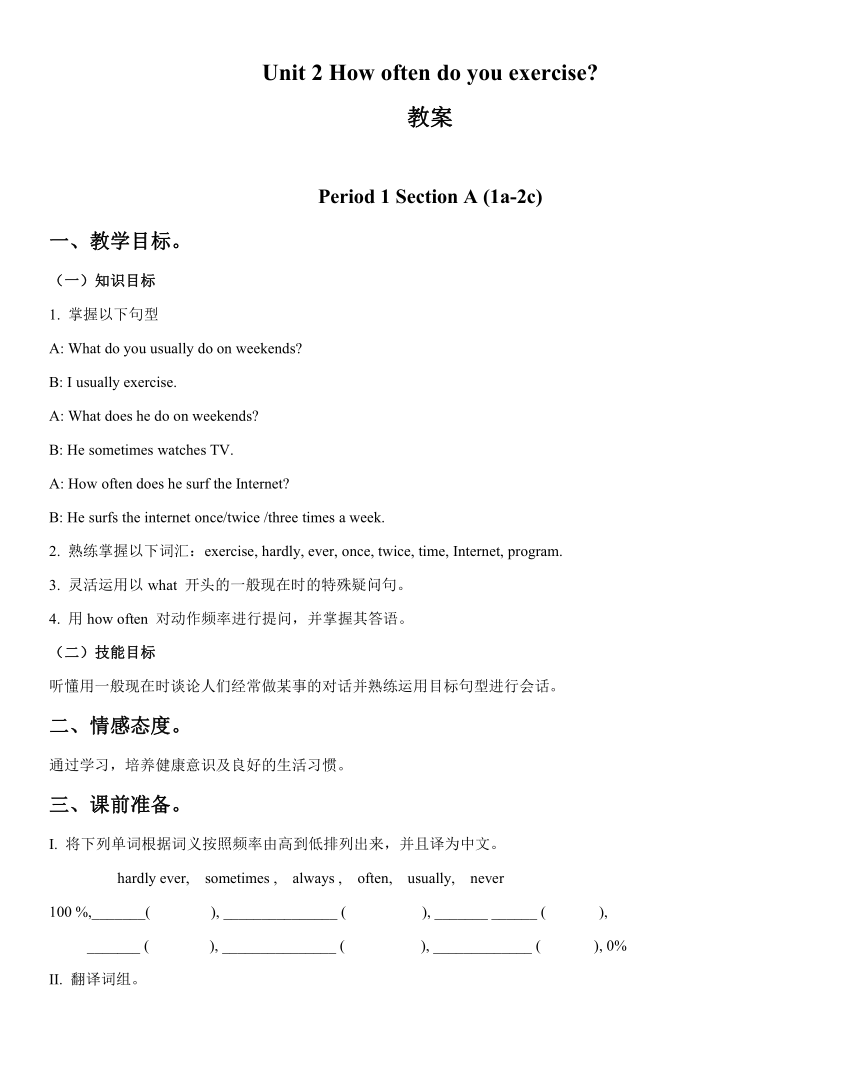 | |
| 格式 | zip | ||
| 文件大小 | 149.5KB | ||
| 资源类型 | 教案 | ||
| 版本资源 | 人教新目标(Go for it)版 | ||
| 科目 | 英语 | ||
| 更新时间 | 2017-10-09 15:11:39 | ||
图片预览

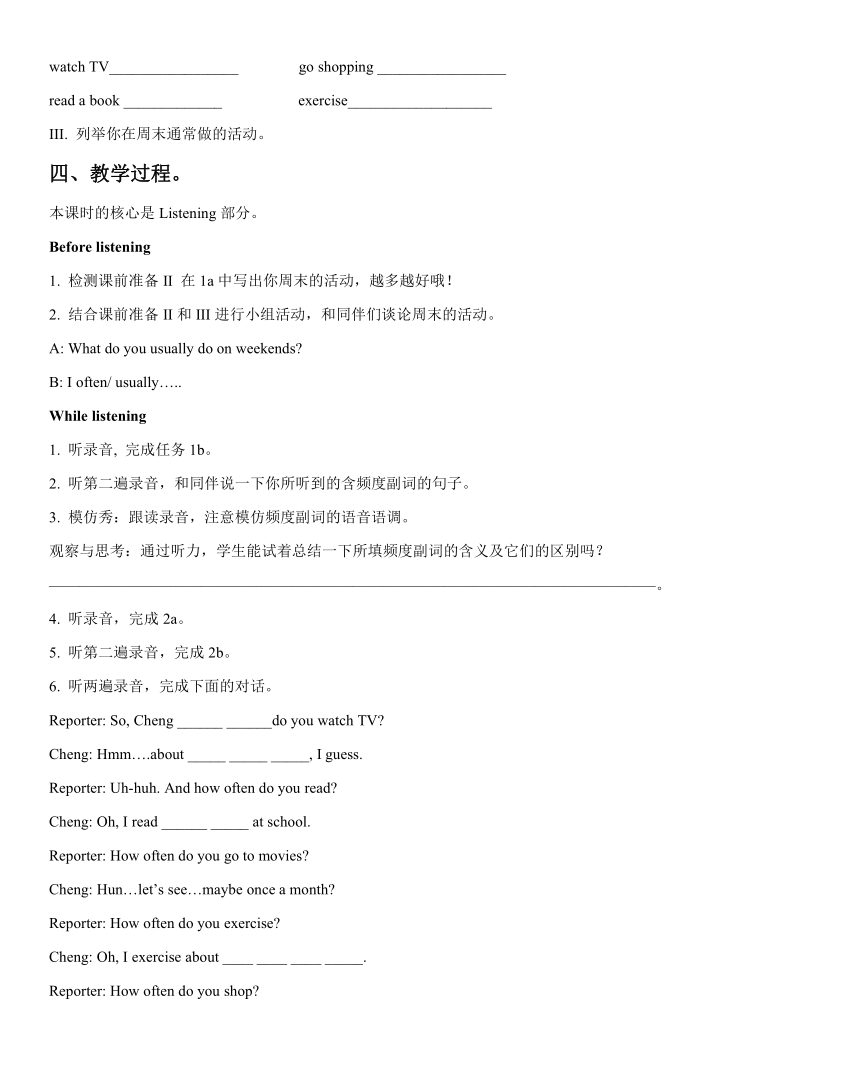
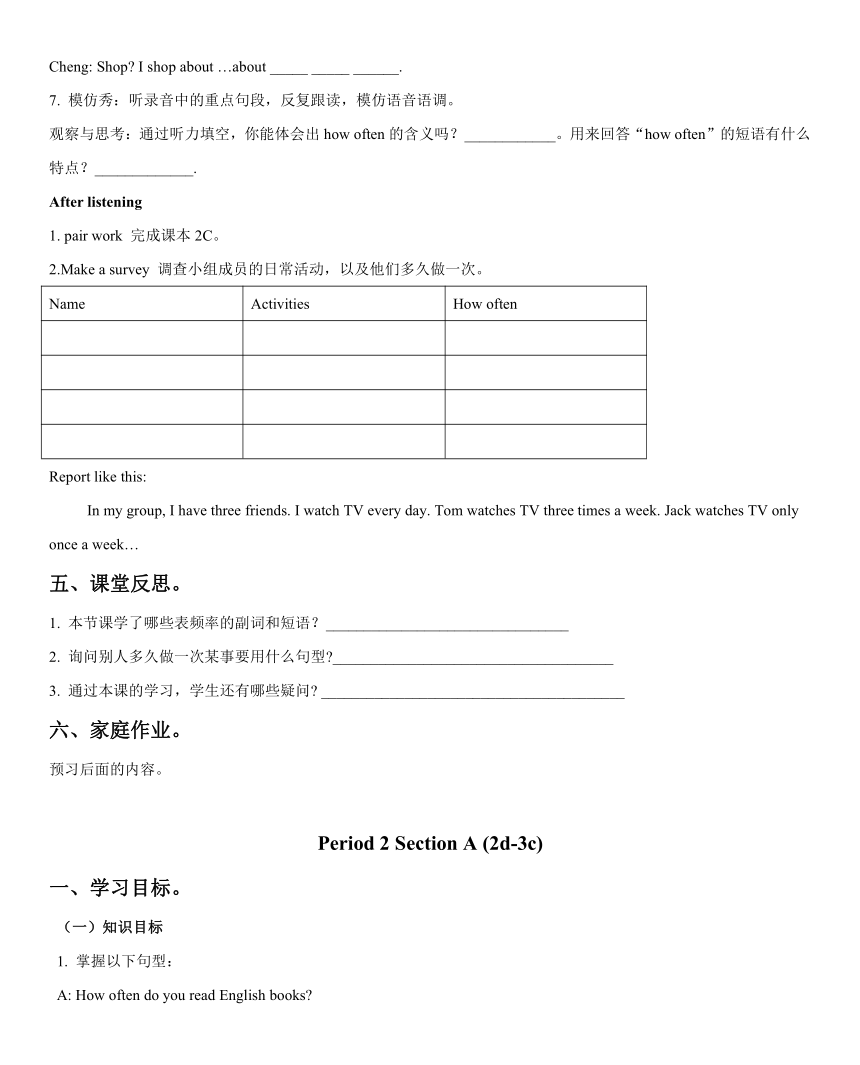
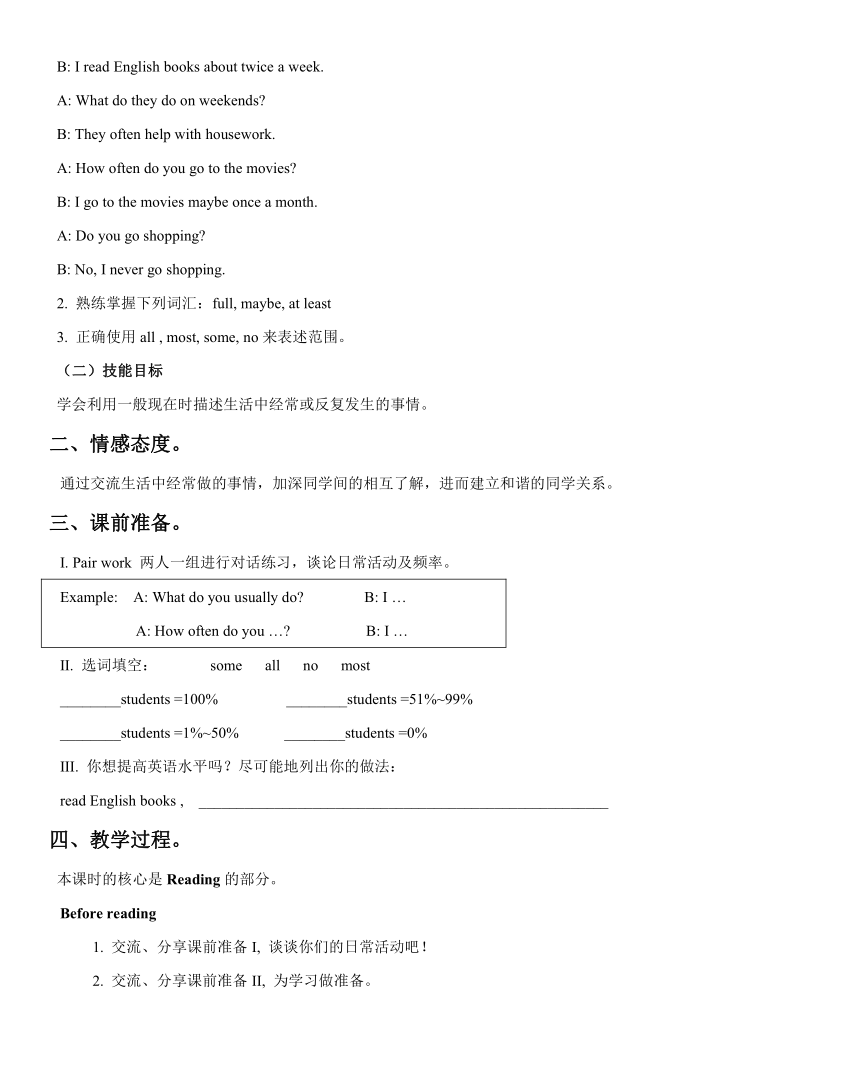
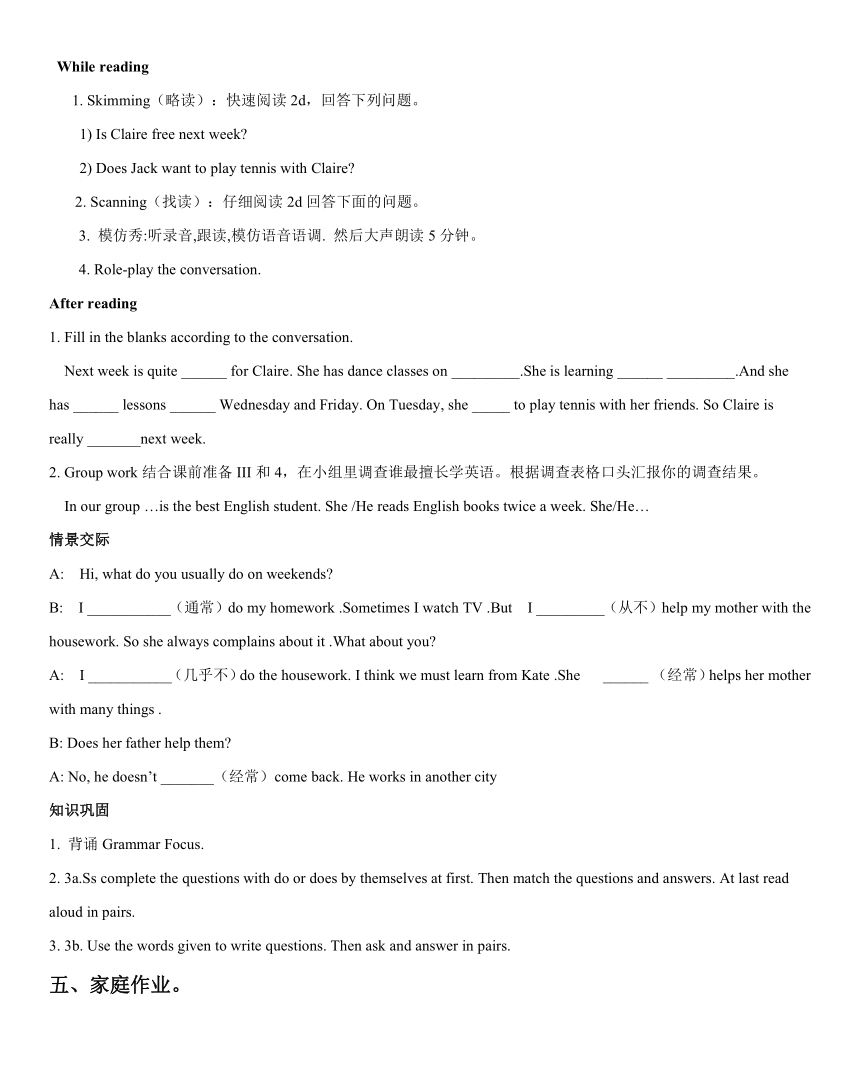
文档简介
Unit
2
How
often
do
you
exercise
教案
Period
1
Section
A
(1a-2c)
一、教学目标。
(一)知识目标
1.
掌握以下句型
A:
What
do
you
usually
do
on
weekends
B:
I
usually
exercise.
A:
What
does
he
do
on
weekends
B:
He
sometimes
watches
TV.
A:
How
often
does
he
surf
the
Internet
B:
He
surfs
the
internet
once/twice
/three
times
a
week.
2.
熟练掌握以下词汇:exercise,
hardly,
ever,
once,
twice,
time,
Internet,
program.
3.
灵活运用以what
开头的一般现在时的特殊疑问句。
4.
用how
often
对动作频率进行提问,并掌握其答语。
(二)技能目标
听懂用一般现在时谈论人们经常做某事的对话并熟练运用目标句型进行会话。
二、情感态度。
通过学习,培养健康意识及良好的生活习惯。
三、课前准备。
I.
将下列单词根据词义按照频率由高到低排列出来,并且译为中文。
hardly
ever,
sometimes
,
always
,
often,
usually,
never
100
%,_______(
),
_______________
(
),
_______
______
(
),
_______
(
),
_______________
(
),
_____________
(
),
0%
II.
翻译词组。
watch
TV_________________
go
shopping
_________________
read
a
book
_____________
exercise___________________
III.
列举你在周末通常做的活动。
四、教学过程。
本课时的核心是Listening部分。
Before
listening
1.
检测课前准备II
在1a中写出你周末的活动,越多越好哦!
2.
结合课前准备II和III进行小组活动,和同伴们谈论周末的活动。
A:
What
do
you
usually
do
on
weekends
B:
I
often/
usually…..
While
listening
1.
听录音,
完成任务1b。
2.
听第二遍录音,和同伴说一下你所听到的含频度副词的句子。
3.
模仿秀:跟读录音,注意模仿频度副词的语音语调。
观察与思考:通过听力,学生能试着总结一下所填频度副词的含义及它们的区别吗?————————————————————————————————————————。
4.
听录音,完成2a。
5.
听第二遍录音,完成2b。
6.
听两遍录音,完成下面的对话。
Reporter:
So,
Cheng
______
______do
you
watch
TV
Cheng:
Hmm….about
_____
_____
_____,
I
guess.
Reporter:
Uh-huh.
And
how
often
do
you
read
Cheng:
Oh,
I
read
______
_____
at
school.
Reporter:
How
often
do
you
go
to
movies
Cheng:
Hun…let’s
see…maybe
once
a
month
Reporter:
How
often
do
you
exercise
Cheng:
Oh,
I
exercise
about
____
____
____
_____.
Reporter:
How
often
do
you
shop
Cheng:
Shop
I
shop
about
…about
_____
_____
______.
7.
模仿秀:听录音中的重点句段,反复跟读,模仿语音语调。
观察与思考:通过听力填空,你能体会出how
often的含义吗?____________。用来回答“how
often”的短语有什么特点?_____________.
After
listening
1.
pair
work
完成课本2C。
2.Make
a
survey
调查小组成员的日常活动,以及他们多久做一次。
Name
Activities
How
often
Report
like
this:
In
my
group,
I
have
three
friends.
I
watch
TV
every
day.
Tom
watches
TV
three
times
a
week.
Jack
watches
TV
only
once
a
week…
五、课堂反思。
1.
本节课学了哪些表频率的副词和短语?________________________________
2.
询问别人多久做一次某事要用什么句型 _____________________________________
3.
通过本课的学习,学生还有哪些疑问
________________________________________
六、家庭作业。
预习后面的内容。
Period
2
Section
A
(2d-3c)
一、学习目标。
(一)知识目标
1.
掌握以下句型:
A:
How
often
do
you
read
English
books
B:
I
read
English
books
about
twice
a
week.
A:
What
do
they
do
on
weekends
B:
They
often
help
with
housework.
A:
How
often
do
you
go
to
the
movies
B:
I
go
to
the
movies
maybe
once
a
month.
A:
Do
you
go
shopping
B:
No,
I
never
go
shopping.
2.
熟练掌握下列词汇:full,
maybe,
at
least
3.
正确使用all
,
most,
some,
no来表述范围。
(二)技能目标
学会利用一般现在时描述生活中经常或反复发生的事情。
二、情感态度。
通过交流生活中经常做的事情,加深同学间的相互了解,进而建立和谐的同学关系。
三、课前准备。
I.
Pair
work
两人一组进行对话练习,谈论日常活动及频率。
Example:
A:
What
do
you
usually
do
B:
I …A:
How
often
do
you
…
B:
I …
II.
选词填空:
some
all
no
most
________students
=100%
________students
=51%~99%
________students
=1%~50%
________students
=0%
III.
你想提高英语水平吗?尽可能地列出你的做法:
read
English
books
,
______________________________________________________
四、教学过程。
本课时的核心是Reading的部分。
Before
reading
1.
交流、分享课前准备I,
谈谈你们的日常活动吧!
2.
交流、分享课前准备II,
为学习做准备。
While
reading
1.
Skimming(略读):快速阅读2d,回答下列问题。
1)
Is
Claire
free
next
week
2)
Does
Jack
want
to
play
tennis
with
Claire
2.
Scanning(找读):仔细阅读2d回答下面的问题。
3.
模仿秀:听录音,跟读,模仿语音语调.
然后大声朗读5分钟。
4.
Role-play
the
conversation.
After
reading
1.
Fill
in
the
blanks
according
to
the
conversation.
Next
week
is
quite
______
for
Claire.
She
has
dance
classes
on
_________.She
is
learning
______
_________.And
she
has
______
lessons
______
Wednesday
and
Friday.
On
Tuesday,
she
_____
to
play
tennis
with
her
friends.
So
Claire
is
really
_______next
week.
2.
Group
work结合课前准备III和4,在小组里调查谁最擅长学英语。根据调查表格口头汇报你的调查结果。
In
our
group
…is
the
best
English
student.
She
/He
reads
English
books
twice
a
week.
She/He…
情景交际
A:
Hi,
what
do
you
usually
do
on
weekends
B:
I
___________(通常)do
my
homework
.Sometimes
I
watch
TV
.But
I
_________(从不)help
my
mother
with
the
housework.
So
she
always
complains
about
it
.What
about
you
A:
I
___________(几乎不)do
the
housework.
I
think
we
must
learn
from
Kate
.She
______
(经常)helps
her
mother
with
many
things
.
B:
Does
her
father
help
them
A:
No,
he
doesn’t
_______(经常)come
back.
He
works
in
another
city
知识巩固
1.
背诵Grammar
Focus.
2.
3a.Ss
complete
the
questions
with
do
or
does
by
themselves
at
first.
Then
match
the
questions
and
answers.
At
last
read
aloud
in
pairs.
3.
3b.
Use
the
words
given
to
write
questions.
Then
ask
and
answer
in
pairs.
五、家庭作业。
1.
跟读并完成After
reading
中的2,将调查报告写到作业本上。
2.
预习后面的内容。
Period
3
Section
B
(1a-1e)
一、学习目标。
(一)知识目标
1.
掌握以下句型:
A:
How
often
do
you
drink
milk
B:
I
drink
milk
every
day.
A:
Do
you
like
it
B:
No,
but
my
mother
wants
me
to
drink
it.
She
says
it’s
good
for
my
health.
A:
How
many
hours
do
you
sleep
every
night
B:
I
sleep
six
hours.
2.
熟练掌握以下词汇:
milk,
coffee,
chocolate
,
drink,
health.
3.
掌握并能正确使用本课时的重点短语:be
good
for
4.
能正确使用how
many
对可数名词的复数提问。
(二)技能目标
讨论有关饮食方面和生活习惯方面的频率,进一步巩固how
often
引导的句型。
二、情感态度。
通过交流饮食习惯,了解什么是健康的生活饮食习惯,培养学生健康生活意识。
三、课前准备。
1.
列出自己学过的有关水果、蔬菜及食品的名称,小组交流后,大声朗读,互相纠正发音。
水果(fruits)_________________________
蔬菜(vegetables)______________________
饮料(drinks)_________________________肉类(meat)
_________________________
食品(foods)__________________________
II.
请试着回答下面的问题,可参考课前准备I与本单元单词表。
What
do
you
often
eat
________________________________
What
do
you
often
drink
_______________________________
How
often
do
you
exercise
____________________________
How
many
hours
do
you
sleep
every
day
_________________
Are
you
healthy _____________________________________
III.
group
work
调查一下谁是班上最健康的学生,完成下表。
What
sports
do
you
often
play
What
do
you
often
eat
How
many
hours
do
you
sleep
Lucy
总结谁是最健康的学生。
I
think…is
the
healthiest
student.
He
/She
plays
…every
day.
He
often
eats…He/She
sleeps
…hours
every
night.
四、教学过程。
本课时的核心是Listening部分。
Before
listening
1.
检测课前准备I,完成1a.
2.
小组交流课前准备II和III。
3.
pair
work
使用1a中所给的单词,两人一组表演1b的对话。
观察与思考:be
good
for
意为“对…有好处”,其反义词为______。
当表示“擅长某一学科知识或某种技能”或“在…方面做得好”时,
我们用_______,其后跟动词的_______。be
good
to
表示_____,
其中good
可用friendly
代替。
While
listening
1.
记者正在和Tina
,
Bill
讨论关于他们的生活习惯。听录音,完成1c.
2.
听第二遍录音,判断所给句子的正(T)、误(F)。
(1)
Tina
exercises
every
day.
(
)
(2)
Tina
eats
vegetables
every
day,
but
she
doesn’t
eat
fruit.
(
)
(3)
Bill
sometimes
eats
vegetables,
but
he
never
eats
fruit.
(
)
(4)
Tina
and
Bill
both
sleep
nine
hours
every
night.
(
)
(5)Tina
and
Bill
both
eat
junk
food
two
or
three
times
a
week.
(
)
(6)
Bill
drinks
coffee
four
times
a
day,
but
Tina
doesn’t
drink
it.
(
)
3.
再听两遍对话,完成1d.
Check
like
this:
A:
How
often
does
Tina
exercise
B:
She
exercises
every
day.
4.
模仿秀:跟读录音,模仿语音语调。
观察与思考:通过刚才的听力训练,请总结。
询问别人生活习惯要用句型:_________________________________
询问别人每天睡眠几小时要用句型:_________________________________________
用来表达自己生活习惯常用的表频率的短语有:_____________________________________
After
listening
1.
Role
play
三人一组,根据1d中的问题和答案,分角色扮演刚才所听到的对话。
2.
Interview一学生就1d中的6个问题对班里同学随机采访,并让学生根据现场采访情况,用第三人称口头作文,描述采访情况。
I
think…is
quite
healthy,
He
does
sports
every
day.
He
likes
eating
vegetables.
五、课堂反思。
1.
你可以从哪些方面来判断某人是否拥有健康的生活方式?___________________________________________________________________________
2.
怎样才能使自己更健康
_______________________________________________________
3.
通过本课的教学,学生还有哪些疑问
六、家庭作业。
1.
用1d
的问题采访你的同伴,并写出你们的对话。
2.
试着把课上的调查汇报写下来。
3.
依据下一个学案的学习目标做好课前准备。
Period
4
Section
B
(2a-2e)
一、学习目标。
(一)知识目标
1.
掌握以下句型:
a.
We
asked
our
students
about
their
free
time
activities.
b.
Here
are
the
results.
c.
We
found
that
only
fifteen
percent
of
our
students
exercise
every
day.
d.
We
were
surprised
that
ninety
percent
of
them
use
the
Internet
every
day.
e.
It
is
good
to
relax
by
using
the
Internet
or
watching
game
shows…
f.
the
best
way
to
relax
is
through
exercise.
g.
It
is
healthy
for
the
mind
and
the
body.
2.
熟练掌握以下词汇:result,
percent,
although,
through,
such
as,
together,
die
3.
掌握并能正确使用本课时的重点短语:use
it
for
fun,
the
answers
to
our
questions
(二)技能目标
完成本课的阅读任务,学会写调查报告。
二、情感态度。
培养学生积极健康的生活和生活习惯。
三、课前准备。
I.
视野拓展
美国2006年的一项调查报告显示,许多美国中小学生为了应付更多的考试而放弃体育课,再加上不良的饮食习惯,造成越来越多的青少年体重超标。美国6至19岁的青少年中有60%,约占900万人体重超标,较1980年增加了三倍。
调查报告指出,联邦政府2001年出台了“一个孩子都不落下”计划,要求学校重视数学和阅读课程,所有学生在毕业前必须参加联邦会考。如果学校连续两年及格率未达标,将被要求增加相关师资,学生也有权要求转学。许多学校为了加强数学和阅读教学,开始减少“次要”课程,
而体育课往往就成了牺牲品。美国中小学正常上体育课的学生比例已从1991年的42%大幅降至2003年的28%。
报告还指出,学生缺乏锻炼的问题已经很严重,再加上学校食堂提供的多是含高糖、高脂和高热量的快餐,不合理的饮食更加剧了学生体质的恶化。
II.
请判断下列习惯是否健康,健康的请写上“healthy”,
不健康的请写上“unhealthy”.
1.He
exercises
at
least(至少)four
or
five
days
a
week.
(
)
2.
He
always
drinks
cola
before
lunch.
(
)
3.
She
eats
junk
food
every
day.
(
)
4.
She
eats
vegetables
only
twice
a
week.
(
)
5.
He
tries
to
drink
milk
every
day.
(
)
四、教学过程。
本课时的核心是Reading部分。
Before
reading
Answer
the
following
questions:
1.
How
often
do
you
watch
television
2.
How
often
do
you
use
the
Internet
3.
How
often
do
you
exercise
While
reading
1.
Skimming(略读):快速阅读文章,完成段落与段落大意连线。
Paragraph
1.
about
exercising
Paragraph
2
about
watching
television
Paragraph
3
here
are
the
results.
Paragraph
4
about
using
the
Internet
Paragraph
5
the
best
way
to
relax
2.
Scanning(找读):
Task
1
细读文章,完成2b填空。
Task2
再读文章,回答2c问题
3.
Reading
up(研读):
a.
自主学习----------找出重、难点________________________________
b.
合作探究-----细读全文,提出疑难问题,小组讨论,互相解答。
4.
模仿秀:听录音并跟读,注意语音、语调。
观察与思考:
联系上下文,你会翻译下列句子吗?
Here
are
the
results.
It
is
good
to
relax
by
using
the
Internet
or
watching
game
shows…
观察划线部分总结重点句型。倒装句型
Here/there
+be+名词。Here
___
your
book.
It
is
+形容词+to
do
sth.
如,It
is
good
to
exercise
every
day.
It
is
important
to
learn
English.
It
是---------主语,不定式短语
to
do
sth.是真正的主语。
It
is
interesting
____
_____
(see)
English
films.
2.
通过阅读2b你能总结一下如何写调查报告吗?
综述(开头)
分述(主要内容)exercise
,
use
of
the
Internet
,
watching
TV
结论建议(结尾)
试着结合上面的结构分析,小组合作,复述课文。
After
reading
1.
完成2d,然后和同伴交流答案。
2.
试着结合上面的结构分析,根据下列提示词,复述课文。
…asked…about
…
questions
were
about…
here
are
…
we
found
that…(exercising)
40%
4-6
times
15%
every
day
20%
1-3times
20%
do
not
…at
all
were
surprised
that…(Internet)
90%
use
every
day
the
other
10%
at
least
3-4
times
most
for
fun
the
answers
to(watching
TV)
…2%
watch
1-3
30%
4-6
85%
every
day
it
is
good
to
relax…
it
is
healthy
for…
so
stared
exercising…
Writing
下面是对一个班的学生就几个方面所做的一个调查,请就表格内容写一篇调查报告。
Activity
Survey
Activity
Every
day
Once
or
twice
a
week
Three
or
four
times
a
week
Do
homework
90%
0%
10%
Exercise
15%
55%
30%
100%=all
51%~99%
=most
1%~50%=some
0%=no
开头已给出Here
are
the
results
of
the
students
activity
survey.
Most
students
______________________________________________________________________________________________________________________________________________________________________________________________________________________________________________________________________________________________________________________________________________________________________________________________________________________________________________________________________________________________________________________________________________________________________________________________________________________________________________________________________________________________________________________________________________________________________________________________________
五、课堂反思。
1.
写调查报告时,你可以这样开头:______;这样结尾:________。
2.
通过本课的学习,
学生还有哪些疑问?____________
Period
5
Section
B
(3a-Self
Check)
一、学习目标。
(一)知识目标
1.
复习巩固本单元重点句型,重点短语。
2.
熟练掌握以下词汇:magazine,
however,
than,
more
than,
almost,
none,
less,
less
than,
point
(二)技能目标
1.
完成3a,3b,3c
2.
学会介绍自己的好习惯和坏习惯。
二、情感态度。
培养学生积极健康的生活和生活习惯。
三、课前准备。
I.
将下列单词根据词义按照频率由高到低排列出来,并且译为中文。
hardly
ever,
sometimes
,
always
,
often,
usually,
never
100
%,_______(
),
_______________
(
),
_______
______
(
),
_______
(
),
________________
(
),
_____________
(
),
0%
II.
根据自己地情况完成下表.
activities
How
often
Good
habits
Bad
habits
四、教学过程。
1.
Free
talk
A:
Do
you
always
exercise
B:
….
A:
Do
you
read
books
every
day
B:
….
A:
Do
you
often
drink
juice
B:
…
A:
How
often
do
you
stay
up
late
B:
…
2.
Reading
a.
快速浏览3a,回答下列问题:
Does
Jane
have
any
bad
habits
Does
she
exercise
every
day
细读3a,根据图表完成报告。小组内交流答案。
b.
分析文章结构:先总写,然后写___________,最后写
__________。
c.
朗读短文,
然后根据图表复述短文。
3.
Writing
根据课前准备II
写一篇关于自己的好习惯和坏习惯报告的。可以参考3a的结构。
小组内交流批改,然后集体范批一到两篇。最后自批并抄写在作文本上。
4.
Take
the
health
quiz.
Who
is
healthier
5.
Self
Check.
Complete
the
blanks
in
1、2、3,
then
read.
五、家庭作业。
复习整个单元,并预习下一单元。
2
How
often
do
you
exercise
教案
Period
1
Section
A
(1a-2c)
一、教学目标。
(一)知识目标
1.
掌握以下句型
A:
What
do
you
usually
do
on
weekends
B:
I
usually
exercise.
A:
What
does
he
do
on
weekends
B:
He
sometimes
watches
TV.
A:
How
often
does
he
surf
the
Internet
B:
He
surfs
the
internet
once/twice
/three
times
a
week.
2.
熟练掌握以下词汇:exercise,
hardly,
ever,
once,
twice,
time,
Internet,
program.
3.
灵活运用以what
开头的一般现在时的特殊疑问句。
4.
用how
often
对动作频率进行提问,并掌握其答语。
(二)技能目标
听懂用一般现在时谈论人们经常做某事的对话并熟练运用目标句型进行会话。
二、情感态度。
通过学习,培养健康意识及良好的生活习惯。
三、课前准备。
I.
将下列单词根据词义按照频率由高到低排列出来,并且译为中文。
hardly
ever,
sometimes
,
always
,
often,
usually,
never
100
%,_______(
),
_______________
(
),
_______
______
(
),
_______
(
),
_______________
(
),
_____________
(
),
0%
II.
翻译词组。
watch
TV_________________
go
shopping
_________________
read
a
book
_____________
exercise___________________
III.
列举你在周末通常做的活动。
四、教学过程。
本课时的核心是Listening部分。
Before
listening
1.
检测课前准备II
在1a中写出你周末的活动,越多越好哦!
2.
结合课前准备II和III进行小组活动,和同伴们谈论周末的活动。
A:
What
do
you
usually
do
on
weekends
B:
I
often/
usually…..
While
listening
1.
听录音,
完成任务1b。
2.
听第二遍录音,和同伴说一下你所听到的含频度副词的句子。
3.
模仿秀:跟读录音,注意模仿频度副词的语音语调。
观察与思考:通过听力,学生能试着总结一下所填频度副词的含义及它们的区别吗?————————————————————————————————————————。
4.
听录音,完成2a。
5.
听第二遍录音,完成2b。
6.
听两遍录音,完成下面的对话。
Reporter:
So,
Cheng
______
______do
you
watch
TV
Cheng:
Hmm….about
_____
_____
_____,
I
guess.
Reporter:
Uh-huh.
And
how
often
do
you
read
Cheng:
Oh,
I
read
______
_____
at
school.
Reporter:
How
often
do
you
go
to
movies
Cheng:
Hun…let’s
see…maybe
once
a
month
Reporter:
How
often
do
you
exercise
Cheng:
Oh,
I
exercise
about
____
____
____
_____.
Reporter:
How
often
do
you
shop
Cheng:
Shop
I
shop
about
…about
_____
_____
______.
7.
模仿秀:听录音中的重点句段,反复跟读,模仿语音语调。
观察与思考:通过听力填空,你能体会出how
often的含义吗?____________。用来回答“how
often”的短语有什么特点?_____________.
After
listening
1.
pair
work
完成课本2C。
2.Make
a
survey
调查小组成员的日常活动,以及他们多久做一次。
Name
Activities
How
often
Report
like
this:
In
my
group,
I
have
three
friends.
I
watch
TV
every
day.
Tom
watches
TV
three
times
a
week.
Jack
watches
TV
only
once
a
week…
五、课堂反思。
1.
本节课学了哪些表频率的副词和短语?________________________________
2.
询问别人多久做一次某事要用什么句型 _____________________________________
3.
通过本课的学习,学生还有哪些疑问
________________________________________
六、家庭作业。
预习后面的内容。
Period
2
Section
A
(2d-3c)
一、学习目标。
(一)知识目标
1.
掌握以下句型:
A:
How
often
do
you
read
English
books
B:
I
read
English
books
about
twice
a
week.
A:
What
do
they
do
on
weekends
B:
They
often
help
with
housework.
A:
How
often
do
you
go
to
the
movies
B:
I
go
to
the
movies
maybe
once
a
month.
A:
Do
you
go
shopping
B:
No,
I
never
go
shopping.
2.
熟练掌握下列词汇:full,
maybe,
at
least
3.
正确使用all
,
most,
some,
no来表述范围。
(二)技能目标
学会利用一般现在时描述生活中经常或反复发生的事情。
二、情感态度。
通过交流生活中经常做的事情,加深同学间的相互了解,进而建立和谐的同学关系。
三、课前准备。
I.
Pair
work
两人一组进行对话练习,谈论日常活动及频率。
Example:
A:
What
do
you
usually
do
B:
I …A:
How
often
do
you
…
B:
I …
II.
选词填空:
some
all
no
most
________students
=100%
________students
=51%~99%
________students
=1%~50%
________students
=0%
III.
你想提高英语水平吗?尽可能地列出你的做法:
read
English
books
,
______________________________________________________
四、教学过程。
本课时的核心是Reading的部分。
Before
reading
1.
交流、分享课前准备I,
谈谈你们的日常活动吧!
2.
交流、分享课前准备II,
为学习做准备。
While
reading
1.
Skimming(略读):快速阅读2d,回答下列问题。
1)
Is
Claire
free
next
week
2)
Does
Jack
want
to
play
tennis
with
Claire
2.
Scanning(找读):仔细阅读2d回答下面的问题。
3.
模仿秀:听录音,跟读,模仿语音语调.
然后大声朗读5分钟。
4.
Role-play
the
conversation.
After
reading
1.
Fill
in
the
blanks
according
to
the
conversation.
Next
week
is
quite
______
for
Claire.
She
has
dance
classes
on
_________.She
is
learning
______
_________.And
she
has
______
lessons
______
Wednesday
and
Friday.
On
Tuesday,
she
_____
to
play
tennis
with
her
friends.
So
Claire
is
really
_______next
week.
2.
Group
work结合课前准备III和4,在小组里调查谁最擅长学英语。根据调查表格口头汇报你的调查结果。
In
our
group
…is
the
best
English
student.
She
/He
reads
English
books
twice
a
week.
She/He…
情景交际
A:
Hi,
what
do
you
usually
do
on
weekends
B:
I
___________(通常)do
my
homework
.Sometimes
I
watch
TV
.But
I
_________(从不)help
my
mother
with
the
housework.
So
she
always
complains
about
it
.What
about
you
A:
I
___________(几乎不)do
the
housework.
I
think
we
must
learn
from
Kate
.She
______
(经常)helps
her
mother
with
many
things
.
B:
Does
her
father
help
them
A:
No,
he
doesn’t
_______(经常)come
back.
He
works
in
another
city
知识巩固
1.
背诵Grammar
Focus.
2.
3a.Ss
complete
the
questions
with
do
or
does
by
themselves
at
first.
Then
match
the
questions
and
answers.
At
last
read
aloud
in
pairs.
3.
3b.
Use
the
words
given
to
write
questions.
Then
ask
and
answer
in
pairs.
五、家庭作业。
1.
跟读并完成After
reading
中的2,将调查报告写到作业本上。
2.
预习后面的内容。
Period
3
Section
B
(1a-1e)
一、学习目标。
(一)知识目标
1.
掌握以下句型:
A:
How
often
do
you
drink
milk
B:
I
drink
milk
every
day.
A:
Do
you
like
it
B:
No,
but
my
mother
wants
me
to
drink
it.
She
says
it’s
good
for
my
health.
A:
How
many
hours
do
you
sleep
every
night
B:
I
sleep
six
hours.
2.
熟练掌握以下词汇:
milk,
coffee,
chocolate
,
drink,
health.
3.
掌握并能正确使用本课时的重点短语:be
good
for
4.
能正确使用how
many
对可数名词的复数提问。
(二)技能目标
讨论有关饮食方面和生活习惯方面的频率,进一步巩固how
often
引导的句型。
二、情感态度。
通过交流饮食习惯,了解什么是健康的生活饮食习惯,培养学生健康生活意识。
三、课前准备。
1.
列出自己学过的有关水果、蔬菜及食品的名称,小组交流后,大声朗读,互相纠正发音。
水果(fruits)_________________________
蔬菜(vegetables)______________________
饮料(drinks)_________________________肉类(meat)
_________________________
食品(foods)__________________________
II.
请试着回答下面的问题,可参考课前准备I与本单元单词表。
What
do
you
often
eat
________________________________
What
do
you
often
drink
_______________________________
How
often
do
you
exercise
____________________________
How
many
hours
do
you
sleep
every
day
_________________
Are
you
healthy _____________________________________
III.
group
work
调查一下谁是班上最健康的学生,完成下表。
What
sports
do
you
often
play
What
do
you
often
eat
How
many
hours
do
you
sleep
Lucy
总结谁是最健康的学生。
I
think…is
the
healthiest
student.
He
/She
plays
…every
day.
He
often
eats…He/She
sleeps
…hours
every
night.
四、教学过程。
本课时的核心是Listening部分。
Before
listening
1.
检测课前准备I,完成1a.
2.
小组交流课前准备II和III。
3.
pair
work
使用1a中所给的单词,两人一组表演1b的对话。
观察与思考:be
good
for
意为“对…有好处”,其反义词为______。
当表示“擅长某一学科知识或某种技能”或“在…方面做得好”时,
我们用_______,其后跟动词的_______。be
good
to
表示_____,
其中good
可用friendly
代替。
While
listening
1.
记者正在和Tina
,
Bill
讨论关于他们的生活习惯。听录音,完成1c.
2.
听第二遍录音,判断所给句子的正(T)、误(F)。
(1)
Tina
exercises
every
day.
(
)
(2)
Tina
eats
vegetables
every
day,
but
she
doesn’t
eat
fruit.
(
)
(3)
Bill
sometimes
eats
vegetables,
but
he
never
eats
fruit.
(
)
(4)
Tina
and
Bill
both
sleep
nine
hours
every
night.
(
)
(5)Tina
and
Bill
both
eat
junk
food
two
or
three
times
a
week.
(
)
(6)
Bill
drinks
coffee
four
times
a
day,
but
Tina
doesn’t
drink
it.
(
)
3.
再听两遍对话,完成1d.
Check
like
this:
A:
How
often
does
Tina
exercise
B:
She
exercises
every
day.
4.
模仿秀:跟读录音,模仿语音语调。
观察与思考:通过刚才的听力训练,请总结。
询问别人生活习惯要用句型:_________________________________
询问别人每天睡眠几小时要用句型:_________________________________________
用来表达自己生活习惯常用的表频率的短语有:_____________________________________
After
listening
1.
Role
play
三人一组,根据1d中的问题和答案,分角色扮演刚才所听到的对话。
2.
Interview一学生就1d中的6个问题对班里同学随机采访,并让学生根据现场采访情况,用第三人称口头作文,描述采访情况。
I
think…is
quite
healthy,
He
does
sports
every
day.
He
likes
eating
vegetables.
五、课堂反思。
1.
你可以从哪些方面来判断某人是否拥有健康的生活方式?___________________________________________________________________________
2.
怎样才能使自己更健康
_______________________________________________________
3.
通过本课的教学,学生还有哪些疑问
六、家庭作业。
1.
用1d
的问题采访你的同伴,并写出你们的对话。
2.
试着把课上的调查汇报写下来。
3.
依据下一个学案的学习目标做好课前准备。
Period
4
Section
B
(2a-2e)
一、学习目标。
(一)知识目标
1.
掌握以下句型:
a.
We
asked
our
students
about
their
free
time
activities.
b.
Here
are
the
results.
c.
We
found
that
only
fifteen
percent
of
our
students
exercise
every
day.
d.
We
were
surprised
that
ninety
percent
of
them
use
the
Internet
every
day.
e.
It
is
good
to
relax
by
using
the
Internet
or
watching
game
shows…
f.
the
best
way
to
relax
is
through
exercise.
g.
It
is
healthy
for
the
mind
and
the
body.
2.
熟练掌握以下词汇:result,
percent,
although,
through,
such
as,
together,
die
3.
掌握并能正确使用本课时的重点短语:use
it
for
fun,
the
answers
to
our
questions
(二)技能目标
完成本课的阅读任务,学会写调查报告。
二、情感态度。
培养学生积极健康的生活和生活习惯。
三、课前准备。
I.
视野拓展
美国2006年的一项调查报告显示,许多美国中小学生为了应付更多的考试而放弃体育课,再加上不良的饮食习惯,造成越来越多的青少年体重超标。美国6至19岁的青少年中有60%,约占900万人体重超标,较1980年增加了三倍。
调查报告指出,联邦政府2001年出台了“一个孩子都不落下”计划,要求学校重视数学和阅读课程,所有学生在毕业前必须参加联邦会考。如果学校连续两年及格率未达标,将被要求增加相关师资,学生也有权要求转学。许多学校为了加强数学和阅读教学,开始减少“次要”课程,
而体育课往往就成了牺牲品。美国中小学正常上体育课的学生比例已从1991年的42%大幅降至2003年的28%。
报告还指出,学生缺乏锻炼的问题已经很严重,再加上学校食堂提供的多是含高糖、高脂和高热量的快餐,不合理的饮食更加剧了学生体质的恶化。
II.
请判断下列习惯是否健康,健康的请写上“healthy”,
不健康的请写上“unhealthy”.
1.He
exercises
at
least(至少)four
or
five
days
a
week.
(
)
2.
He
always
drinks
cola
before
lunch.
(
)
3.
She
eats
junk
food
every
day.
(
)
4.
She
eats
vegetables
only
twice
a
week.
(
)
5.
He
tries
to
drink
milk
every
day.
(
)
四、教学过程。
本课时的核心是Reading部分。
Before
reading
Answer
the
following
questions:
1.
How
often
do
you
watch
television
2.
How
often
do
you
use
the
Internet
3.
How
often
do
you
exercise
While
reading
1.
Skimming(略读):快速阅读文章,完成段落与段落大意连线。
Paragraph
1.
about
exercising
Paragraph
2
about
watching
television
Paragraph
3
here
are
the
results.
Paragraph
4
about
using
the
Internet
Paragraph
5
the
best
way
to
relax
2.
Scanning(找读):
Task
1
细读文章,完成2b填空。
Task2
再读文章,回答2c问题
3.
Reading
up(研读):
a.
自主学习----------找出重、难点________________________________
b.
合作探究-----细读全文,提出疑难问题,小组讨论,互相解答。
4.
模仿秀:听录音并跟读,注意语音、语调。
观察与思考:
联系上下文,你会翻译下列句子吗?
Here
are
the
results.
It
is
good
to
relax
by
using
the
Internet
or
watching
game
shows…
观察划线部分总结重点句型。倒装句型
Here/there
+be+名词。Here
___
your
book.
It
is
+形容词+to
do
sth.
如,It
is
good
to
exercise
every
day.
It
is
important
to
learn
English.
It
是---------主语,不定式短语
to
do
sth.是真正的主语。
It
is
interesting
____
_____
(see)
English
films.
2.
通过阅读2b你能总结一下如何写调查报告吗?
综述(开头)
分述(主要内容)exercise
,
use
of
the
Internet
,
watching
TV
结论建议(结尾)
试着结合上面的结构分析,小组合作,复述课文。
After
reading
1.
完成2d,然后和同伴交流答案。
2.
试着结合上面的结构分析,根据下列提示词,复述课文。
…asked…about
…
questions
were
about…
here
are
…
we
found
that…(exercising)
40%
4-6
times
15%
every
day
20%
1-3times
20%
do
not
…at
all
were
surprised
that…(Internet)
90%
use
every
day
the
other
10%
at
least
3-4
times
most
for
fun
the
answers
to(watching
TV)
…2%
watch
1-3
30%
4-6
85%
every
day
it
is
good
to
relax…
it
is
healthy
for…
so
stared
exercising…
Writing
下面是对一个班的学生就几个方面所做的一个调查,请就表格内容写一篇调查报告。
Activity
Survey
Activity
Every
day
Once
or
twice
a
week
Three
or
four
times
a
week
Do
homework
90%
0%
10%
Exercise
15%
55%
30%
100%=all
51%~99%
=most
1%~50%=some
0%=no
开头已给出Here
are
the
results
of
the
students
activity
survey.
Most
students
______________________________________________________________________________________________________________________________________________________________________________________________________________________________________________________________________________________________________________________________________________________________________________________________________________________________________________________________________________________________________________________________________________________________________________________________________________________________________________________________________________________________________________________________________________________________________________________________________
五、课堂反思。
1.
写调查报告时,你可以这样开头:______;这样结尾:________。
2.
通过本课的学习,
学生还有哪些疑问?____________
Period
5
Section
B
(3a-Self
Check)
一、学习目标。
(一)知识目标
1.
复习巩固本单元重点句型,重点短语。
2.
熟练掌握以下词汇:magazine,
however,
than,
more
than,
almost,
none,
less,
less
than,
point
(二)技能目标
1.
完成3a,3b,3c
2.
学会介绍自己的好习惯和坏习惯。
二、情感态度。
培养学生积极健康的生活和生活习惯。
三、课前准备。
I.
将下列单词根据词义按照频率由高到低排列出来,并且译为中文。
hardly
ever,
sometimes
,
always
,
often,
usually,
never
100
%,_______(
),
_______________
(
),
_______
______
(
),
_______
(
),
________________
(
),
_____________
(
),
0%
II.
根据自己地情况完成下表.
activities
How
often
Good
habits
Bad
habits
四、教学过程。
1.
Free
talk
A:
Do
you
always
exercise
B:
….
A:
Do
you
read
books
every
day
B:
….
A:
Do
you
often
drink
juice
B:
…
A:
How
often
do
you
stay
up
late
B:
…
2.
Reading
a.
快速浏览3a,回答下列问题:
Does
Jane
have
any
bad
habits
Does
she
exercise
every
day
细读3a,根据图表完成报告。小组内交流答案。
b.
分析文章结构:先总写,然后写___________,最后写
__________。
c.
朗读短文,
然后根据图表复述短文。
3.
Writing
根据课前准备II
写一篇关于自己的好习惯和坏习惯报告的。可以参考3a的结构。
小组内交流批改,然后集体范批一到两篇。最后自批并抄写在作文本上。
4.
Take
the
health
quiz.
Who
is
healthier
5.
Self
Check.
Complete
the
blanks
in
1、2、3,
then
read.
五、家庭作业。
复习整个单元,并预习下一单元。
同课章节目录
- Unit 1 Where did you go on vacation?
- Section A
- Section B
- Unit 2 How often do you exercise?
- Section A
- Section B
- Unit 3 I'm more outgoing than my sister.
- Section A
- Section B
- Unit 4 What's the best movie theater?
- Section A
- Section B
- Unit 5 Do you want to watch a game show?
- Section A
- Section B
- Unit 6 I'm going to study computer science.
- Section A
- Section B
- Unit 7 Will people have robots?
- Section A
- Section B
- Unit 8 How do you make a banana milk shake?
- Section A
- Section B
- Unit 9 Can you come to my party?
- Section A
- Section B
- Unit 10 If you go to the party, you'll have a grea
- Section A
- Section B
